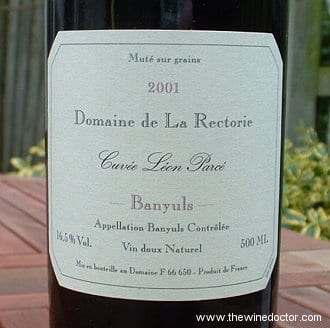Domaine de la Rectorie Banyuls Cuvée Leon Parcé 2001
After a less than thrilling vintage Port from Taylor’s, from the 1975 vintage (which is perhaps the prime reason why it was so unexciting) I was recently in the cellar on the lookout for something similar but which was perhaps likely to give a little more pleasure. My hand fell on this, one of a number of cuvées of Banyuls turned out by Marc Parcé at Domaine de la Rectorie. Banyuls is one of the Mediterranean’s best known examples of vin doux naturel. The term translates as ‘naturally sweet’, but it is perhaps not really a good one to describe the wines. I hold that if there any wines that should be described as ‘naturally’ sweet, they are those where the concentration of sugars in the grapes when harvested is so high that the fermenting yeasts die, poisoned by alcohol, long before all the sugar has been converted. Admittedly the wealth of sugar results usually from dehydration, such as with botrytis and late harvest styles, so even here it is a result of a small degree of manipulation, namely delaying the harvest while one or both of these processes take effect. With mutage, however, the yeast action is halted by the addition of alcohol, resulting in what is really a blend of partially fermented grape juice, the derived alcohol and added grape spirit. The most common styles involve Muscat, as in Muscat de St Jean de Minervois and Muscat de Beaumes de Venise, and Grenache, as in Maury and of course this week’s wine, Banyuls.
 Banyuls, unlike Maury which may be red or white, only has an appellation for red wines. Grenache is the dominant variety, comprising 50% of the blend for straight Banyuls, at least 75% for Banyuls Grand Cru. Other permissible varieties include Maccabeu, Tourbat and Muscat, and also Carignan, Cinsaut and Syrah (provided these do not exceed 10%), all varieties familiar to fans of the wines of Roussillon. This region might be regarded as the birthplace of the vin doux naturel method in France, as it was here that Arnaud de Villeneuve perfected the technique in the 13th Century. An eminent physician associated with the University of Montpellier, de Villeneuve demonstrated that the addition of spirit to the must halted fermentation, and so won a patent from the king of Majorca, who then ruled Roussillon, to produce wines in the region using the method. This may have been something of a surprise to de Villeneuve, who was far more interested in the science of distillation and of the medicinal properties of the products thus obtained than any new style of wine. Nevertheless, centuries later, Arnaud’s method of mutage remains essentially unchanged, and it is exactly the process (although the source of the spirit used has no doubt changed over the intervening centuries) used to produce this week’s wine, the 2001 Cuvée Leon Parcé from Domaine de la Rectorie.
Banyuls, unlike Maury which may be red or white, only has an appellation for red wines. Grenache is the dominant variety, comprising 50% of the blend for straight Banyuls, at least 75% for Banyuls Grand Cru. Other permissible varieties include Maccabeu, Tourbat and Muscat, and also Carignan, Cinsaut and Syrah (provided these do not exceed 10%), all varieties familiar to fans of the wines of Roussillon. This region might be regarded as the birthplace of the vin doux naturel method in France, as it was here that Arnaud de Villeneuve perfected the technique in the 13th Century. An eminent physician associated with the University of Montpellier, de Villeneuve demonstrated that the addition of spirit to the must halted fermentation, and so won a patent from the king of Majorca, who then ruled Roussillon, to produce wines in the region using the method. This may have been something of a surprise to de Villeneuve, who was far more interested in the science of distillation and of the medicinal properties of the products thus obtained than any new style of wine. Nevertheless, centuries later, Arnaud’s method of mutage remains essentially unchanged, and it is exactly the process (although the source of the spirit used has no doubt changed over the intervening centuries) used to produce this week’s wine, the 2001 Cuvée Leon Parcé from Domaine de la Rectorie.
In the glass this Banyuls has a very dark, red-black, glossy and shimmering hue. The nose is vibrant and forward, showing piles of sweet, roasted, smoky-cherry fruit. Although this dominates, there are in the background little nuances of roasted meats, leather and tobacco, and there is also a floral delicacy to it, like gentle flower petals. The palate is rich and sweet, but bright, well-delineated and pure. There is cherry fruit with a smoky edge, as on the nose, and underneath I find some beautiful, well-coated tannins. There is a little sweet, roasted, Maillard-like edge to it as well, which provides an appealing note of interest. Overall, this is excellent for sipping now, and it should do very nicely in the cellar too. A real success here. 18/20 (12/1/09)
Find Domaine de la Rectorie Banyuls Cuvée Leon Parce 2001 on Wine Searcher: ![]()
